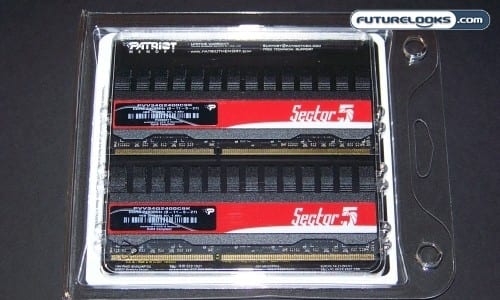
We know a lot of you are sitting there contemplating the purpose behind using 2400MHz of DDR3 memory in your computer. And, to be honest, we sometimes sit here wondering the same thing while trying to figure out possible applications for such memory. It’s usually only limited by our ability to come up with scenarios that would provide the right kind of test and come up with conclusion that benefit users from gamers to benchmark enthusiasts. Of course there are things such as overclocking that really make such a kit shine. Let’s check out just a few more of the things that the Patriot 2400MHz Sector 5 DDR3 can do for your system.
Features and Specifications

Obviously, half of this memory’s specifications are in the name alone. It’s PC3-19200 and is is capable of running 2400MHz reliably for months on end. What you can’t tell is printed on the modules themselves.
The 2400MHz Sector 5 kit is able to maintain those frequencies using the Extreme Memory Profile, or XMP. The memory timings programmed into the kit’s SPD is 9-11-9-27 at an impressive 1.65 volts. If this were the previous generation DDR3, it would probably need something in the neighborhood of 2.5 volts to be stable at such settings. Thank goodness for memory innovation.
Underneath the spreaders are rumored to be some of the best binned Elpida ICs that exist. The 1.65 volt modules are essentially the most common JEDEC standard. Soon, we’ll be seeing lower voltage DDR3 requiring a meager 1.25 to 1.5 volts to function much like the new Kingston LoVo Modules that we reviewed recently.
The Patriot Viper II Sector 5 Dual Channel 2400MHz DDR3 Kit is priced at $224.99US with some rebates bringing it down to $174.99US. Lower rated Viper II Sector 5 kits are available for slightly less.
Sector 5 Investigation
Alright, at this point in the review, you may or may not be undergoing a scan that clears your for “Secret” security clearance. We can’t have you looking at such high tech stuff that could possibly transform your computer system in to a computational security risk, now can we?

The Sector 5 DDR3 series memory features black ram sinks with stickers stamped with the Sector 5 moniker. This isn’t very high tech itself, but it keeps the cost down. One of these days, we might see some more customized sinks that would properly “wow” enthusiasts indicating exactly what their hard earned money is buying.
Overclocking enthusiasts should consider their motherboard’s capabilities before choosing this particular kit. In order to unlock the memory divider manually or select a programmed XMP profile, your motherboard should be able to hit a 200MHz CPU Bus Clock and it should support upwards of 2000 to 2200MHz DDR3 memory overclocking out of the box. Most motherboards should proudly display this capability on the retail packaging. If it doesn’t, it probably won’t do it or isn’t a very well supported feature.
Power users not so concerned about the upper most extreme aren’t left out. A great number of Intel based motherboards support 1600 to 1800MHz just fine. That means, these users can manually apply these frequencies and can select better performance timings. In other words, instead of leaving it at 9-11-9-27 timings, you can select 7-7-7-21 or 8-8-8-24 which boosts your performance over a stock 1600MHz 9-9-9-27 kit.
System Setup
To properly experience the full range of performance provided by the Viper II Sector 5 2400MHz memory kit, a very capable motherboard is needed. While we have many capable ASUS and GIGABYTE P55 and H55 motherboards, the GIGABYTE GA-P55A-UD6 was selected. While the ASUS Pro and Evo platforms are more than capable, this just happens to be our favourite board of the moment.
Here’s the breakdown of our test system:
- CPU: Intel Core i7-870 Lynnfield LGA1156 Processor
- Motherboard: GIGABYTE GA-P55A-UD6 Motherboard
- Memory Kit 1: Patriot Memory 4GB 2400MHz Sector 5 DDR3 Memory (as tested)
- Memory Kit 2: Patriot Memory 4GB 2000MHz Sector 5 DDR3 Memory (for comparison)
- Video Card: Zotac Geforce GTX 285 Infinity
- Hard Drive/SSD: Patriot Memory 128GB TorqX SSD
- Case/Enclosure: Antec P183 Enclosure and CP-850 Power Supply
- CPU Cooler: Koolance CPU-360 and Exos 2.5
Our operating system of choice was Windows 7 Ultimate 64 bit. All drivers and BIOS were updated to the latest available at the time of this review.
